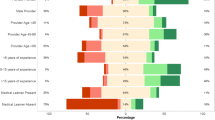Abstract
Background
Prior surveys evaluating women’s perceptions of transvaginal surgery both support and refute the acceptability of transvaginal access. Most surveys employed mainly quantitative analysis, limiting the insight into the women’s perspective. In this mixed-methods study, we include qualitative and quantitative methodology to assess women’s perceptions of transvaginal procedures.
Methods
Women seen at the outpatient clinics of a tertiary-care center were asked to complete a survey. Demographics and preferences for appendectomy, cholecystectomy, and tubal ligation were elicited, along with open-ended questions about concerns or benefits of transvaginal access. Multivariate logistic regression models were constructed to examine the impact of age, education, parity, and prior transvaginal procedures on preferences. For the qualitative evaluation, content analysis by independent investigators identified themes, issues, and concerns raised in the comments.
Results
The completed survey tool was returned by 409 women (grouped mean age 53 years, mean number of 2 children, 82% ≥some college education, and 56% with previous transvaginal procedure). The transvaginal approach was acceptable for tubal ligation to 59%, for appendectomy to 43%, and for cholecystectomy to 41% of the women. The most frequently mentioned factors that would make women prefer a vaginal approach were decreased invasiveness (14.4%), recovery time (13.9%), scarring (13.7%), pain (6%), and surgical entry location relative to organ removed (4.4%). The most frequently mentioned concerns about the vaginal approach were the possibility of complications/safety (14.7%), pain (9%), infection (5.6%), and recovery time (4.9%). A number of women voiced technical concerns about the vaginal approach.
Conclusions
As in prior studies, scarring and pain were important issues to be considered, but recovery time and increased invasiveness were also in the “top five” list. The surveyed women appeared to actively participate in evaluating the technical components of the procedures.


Similar content being viewed by others
References
Solomon D, Lentz R, Duffy A, Bell R, Roberts KE (2011) Female sexual function after pure transvaginal appendectomy: a cohort study. Digestive Disease Week 2011, Conference Proceedings, Chicago, IL
Ott D (1901) Die direkte Beleuchtung der Bauchhoehle, der Harnblase, des Dickdams and des Uterus zu diagnostischen und operativen Zwecken. Rev Med Tcheque (Prague) 2:27–29
Federlein M, Borchert D, Muller V, Atas Y, Fritze F, Burghardt J, Elling D, Gellert K (2010) Transvaginal video-assisted cholecystectomy in clinical practice. Surg Endosc 24:2444–2452
Gero D, Lukovich P, Hulesch B, Palhazy T, Kecskedi B, Kupcsulik P (2010) Inpatients and specialists’ opinions about natural orifice translumenal endoscopic surgery. Surg Technol Int 19:79–84
Omana JJ, Mistry S, Herron D, Kini S (2010) Perception of NOTES among health care workers and medical students. Surg Innov 17:63–68
Peterson CY, Ramamoorthy S, Andrews B, Horgan S, Talamini M, Chock A (2009) Women’s positive perception of transvaginal NOTES surgery. Surg Endosc 23:1770–1774
Strickland AD, Norwood MG, Behnia-Willison F, Olakkengil SA, Hewett PJ (2010) Transvaginal natural orifice translumenal endoscopic surgery (NOTES): a survey of women’s views on a new technique. Surg Endosc 24:2424–2431
Swanstrom LL, Volckmann E, Hungness E, Soper NJ (2009) Patient attitudes and expectations regarding natural orifice translumenal endoscopic surgery. Surg Endosc 23:1519–1525
Tsin DA, Castro-Perez R, Davila MR, Davila F (2010) Postoperative patient attitudes and perceptions of transvaginal cholecystectomy. J Laparoendosc Adv Surg Tech A 20:119–121
Varadarajulu S, Tamhane A, Drelichman E (2008) Patient perception of natural orifice transluminal endoscopic surgery as a technique for cholecystectomy. Gastrointest Endosc 67:854–860
Volckmann ET, Hungness ES, Soper NJ, Swanstrom LL (2009) Surgeon perceptions of Natural Orifice Translumenal Endoscopic Surgery (NOTES). J Gastrointest Surg 13:1401–1410
Becerra Garcia FC, Romo-Medrano Mora KE (2010) Our perception of “Women’s positive perception of transvaginal NOTES surgery”: let the voices be heard, not just counted. Surg Endosc 24:1226–1228
Cohen DJ, Crabtree BF (2008) Evaluative criteria for qualitative research in health care: controversies and recommendations. Ann Family Med 6:331–339
Disclosures
The authors have no disclosures regarding potential conflicts of interest pertaining to this manuscript.
Author information
Authors and Affiliations
Corresponding author
Additional information
A Mayo Foundation Research Early Career Development Award supports Dr. Bingener.
Appendix: Survey tool
Appendix: Survey tool


Rights and permissions
About this article
Cite this article
Bingener, J., Sloan, J.A., Ghosh, K. et al. Qualitative and quantitative analysis of women’s perceptions of transvaginal surgery. Surg Endosc 26, 998–1004 (2012). https://doi.org/10.1007/s00464-011-1984-7
Received:
Accepted:
Published:
Issue Date:
DOI: https://doi.org/10.1007/s00464-011-1984-7



